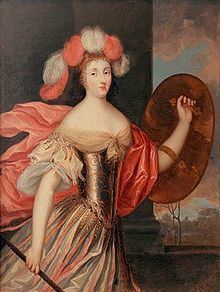Mother Geronima Mazzarini Name Olympia Countess | Role Countess of Soissons Parents Girolama Mazzarini | |
 | ||
Issue Louis Thomas, Count of SoissonsPrince PhilippeLouis Jules, Knight of SavoyEmmanuel Philibert, Count of DreuxPrince EugeneMarie Jeanne, Mademoiselle de SoissonsLouise Philiberte, Mademoiselle de DreuxFrancoise, Mademoiselle de Dreux House House of Savoy-Carignano (by marriage) Father Michele Lorenzo Mancini Spouse Eugene Maurice, Count of Soissons (m. 1657) Children Prince Eugene of Savoy, Louis Thomas, Count of Soissons Grandchildren Thomas Emmanuel, Prince of Savoy-Carignan, Princess Maria Anna Victoria of Savoy Similar People | ||
Olympia Mancini, Countess of Soissons (French: Olympe Mancini; 11 July 1638 – 9 October 1708) was the second eldest of the five celebrated Mancini sisters, who along with two of their female Martinozzi cousins, were known at the court of King Louis XIV of France as the Mazarinettes because their uncle was Louis XIV's chief minister, Cardinal Mazarin. Olympia was later to become the mother of the famous Austrian general Prince Eugene of Savoy. She also involved herself in various court intrigues including the notorious Poison Affair, which led to her expulsion from France.
Contents
Family and early years
Olympia Mancini was born on 11 July 1638 and grew up in Rome. Her father was Baron Lorenzo Mancini, an Italian aristocrat who was also a necromancer and astrologer. After his death in 1650, her mother, Geronima Mazzarini, brought her daughters from Rome to Paris in the hope of using the influence of her brother, Cardinal Mazarin, to gain them advantageous marriages.
The other Mancini sisters were:
The Mancinis were not the only female family members that Cardinal Mazarin brought to the French court. The others were Olympia's first cousins, daughters of Mazarin's eldest sister. The elder, Laura Martinozzi, married Alfonso IV d'Este, Duke of Modena and was the mother of Mary of Modena, second wife of James II of England. The younger, Anne Marie Martinozzi, married Armand, Prince de Conti.
The Mancini also had three brothers: Paul, Philippe, and Alphonse.
Marriage
Olympia was married on 24 February 1657 to Prince Eugène-Maurice of Savoy (1633–1673), by whom she had eight children, amongst whom was the famous soldier Prince Eugene of Savoy. At court, the Count of Soissons (comte Soissons) was addressed as Monsieur le Comte. As his wife, Olympia was referred to at court as Madame la comtesse.
Intrigues
Soon after her sister Marie's marriage to Prince Colonna, Olympia was appointed Superintendent of the Queen's Household which gave her authority over and above that of all of the other ladies at Court with the exception of the Princesses of The Blood. Olympia was, by nature, an intrigante. Shortly after her marriage, she became involved in various intrigues at Court. There were rumours that prior to her marriage, she was briefly the mistress of Louis XIV. While not exactly beautiful, Olympia was described as possessing great charm and indisputable fascination. Her hair was dark, her complexion brilliant, her eyes black and vivacious, and her figure plump and rounded. After her marriage, she allied herself with Louis' sister-in-law, Henriette, Duchess of Orléans, who was known at court as Madame, and with whom he had (allegedly) fallen deeply in love. Their relationship is highly unlikely to have been sexual, although the Queen Mother was deeply concerned about it. When Henriette and Louis sought to hide their relationship from others, Olympia is said to have introduced one of Henriette's ladies-in-waiting, Mademoiselle de La Vallière, to the King so that he might claim that his attendance upon Henriette and her ladies was based on his affection for Louise and not Henriette. Olympia turned against Louise, however, after the King fell in love with the latter at the expense of Henrietta Anne.
The Affaire des Poisons
Olympia was accused in 1679 in the Affaire des Poisons of having plotted with La Voisin to poison Louise de La Vallière. She was even said to have threatened the King himself with the words, "come back to me, or you will be sorry". In addition, she was suspected of poisoning her own husband, and also on 12 February 1689 Queen Maria Luisa of Spain, the daughter of Henriette and niece of Louis XIV whose confidence she had gained after having taken up residence in Spain following her expulsion from France as a result of the Poison Affair.
Later life
On 23 January 1690 she was ordered to leave the Spanish court; she moved to Brussels, claiming her innocence. Occasionally she travelled to England with her two sisters Marie and Hortense. In Brussels she gave her patronage to musicians Pietro Antonio Fiocco and Henry Desmarest. She died in Brussels on 9 October 1708 just three months after her son Eugene's victory at The Battle of Oudenarde on 11 July 1708 which was her 70th birthday.
Family
- Louis Thomas, Count of Soissons (1657–1702) married Urania de La Cropte and had issue
- Philippe, "Abbot of Soissons" (1659–1693) unmarried.
- Louis Jules, Cavaliere of Savoy (1660–1683) killed at the battle of Petronell against the Turks known as the Cavaliere di Savoia
- Emanuel Philibert, Count of Dreux (1662–1676) unmarried.
- Prince Eugene of Savoy (1663–1736) famous general.
- Princess Marie Jeanne of Savoy (1665–1705) Mademoiselle de Soissons.
- Princess Louise Philiberte of Savoy (1667–1726) Mademoiselle de Dreux.
- Princess Françoise of Savoy (1668–1671), Mademoiselle de Dreux.
